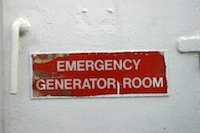 Whenever you’re employing the use of standby generators out on the dangerous open sea, it’s because something with your operation has gone wrong. If you’ve vetted and installed the best-fit emergency or standby generators for your operation, there’s no reason to panic. You’ve already made a plan that will ensure that everything that needs to run will run to keep your bottom line intact and get you back safe and sounds.
Whenever you’re employing the use of standby generators out on the dangerous open sea, it’s because something with your operation has gone wrong. If you’ve vetted and installed the best-fit emergency or standby generators for your operation, there’s no reason to panic. You’ve already made a plan that will ensure that everything that needs to run will run to keep your bottom line intact and get you back safe and sounds.
And if you don’t yet have the plan or the standby generator, don’t worry; we can help. Things to think about when looking for a generator:
- How rugged is the design?
When you’re looking to move a genset out to sea, you’re going to want to be sure it’s built for the rough and wet life of maritime equipment. You’ll want a durable, weatherproof enclosure that will fend off the elements. Remember, this is the back-up plan for power supply, so seek out standby generators that boast more hardcore protection than your primary generators. - What really needs to run on the standby generators?
In other words, how much power do you need? Before answering that, let’s make a quick distinction. There are two reasons you may want to consider standby generators. The first is that your primary power generation may not be enough if you need to draw power for extra equipment, run extra shifts, or add a good deal of weight to your floating operation. The less ideal scenario is that primary power generation has failed – a blackout has occurred from a flood, fire, or some other distaster – and you at least need to maintain the safety of everyone on board, and at the most, keep everything running to maintain production uptime. When you’re looking to supply emergency power for either scenario, carefully match the load to the capacity of the standby generators you’re considering. Err on the side of caution and assume you need more power than you do. - Take all factors into consideration
For starters, it’s important to note that emergency or standby power generators aren’t subject to the same new Tier 4 emissions standards as primary power generators, so you have some flexibility here. Also, when installing the generators, be sure they’re easily accessible; you’ll want to practice weekly testing of these units to make sure that any switches are deployed seamlessly.
In an ideal world, your marine standby generators are only ever used during testing. They never need to provide emergency bandwidth because you don’t encounter any power shortages or failures. The truth is that, more likely than not, you’ll depend heavily on these units when you least expect to. Choose wisely and you won’t need to sweat a blackout when you’re out to sea.



